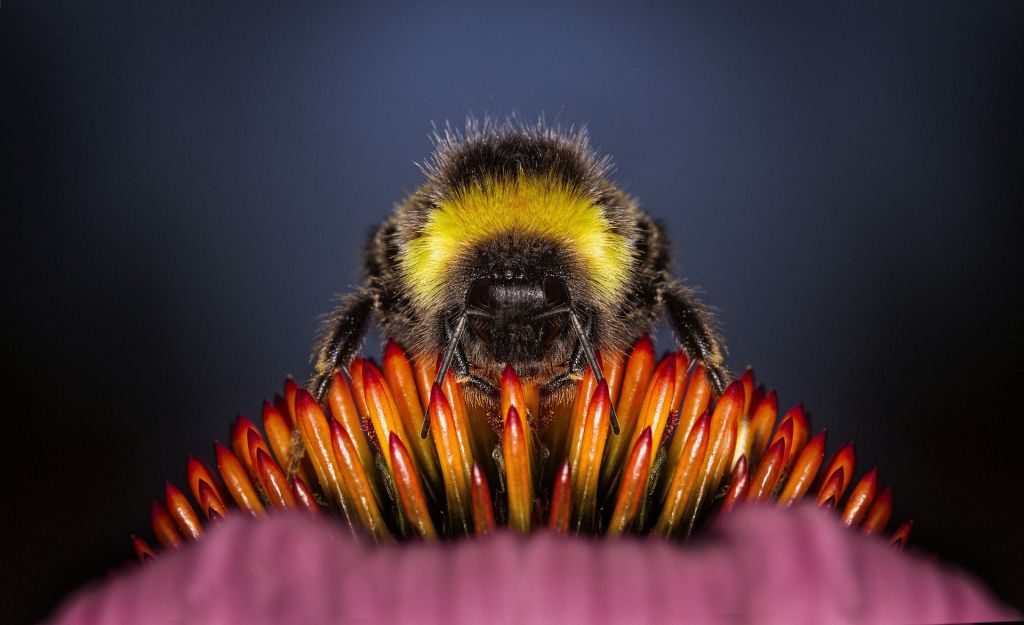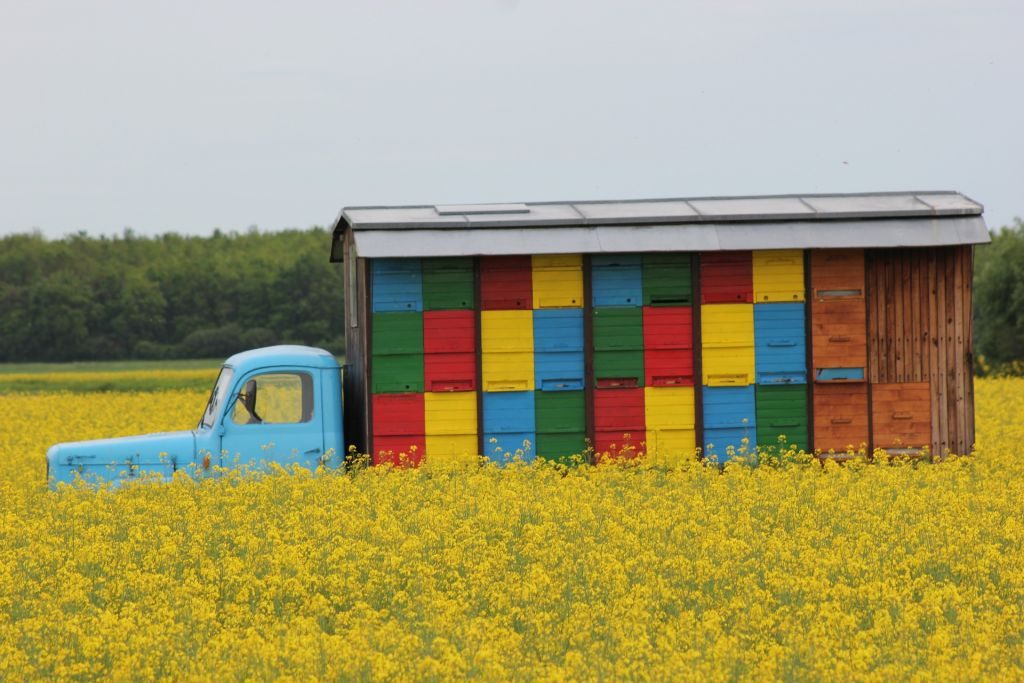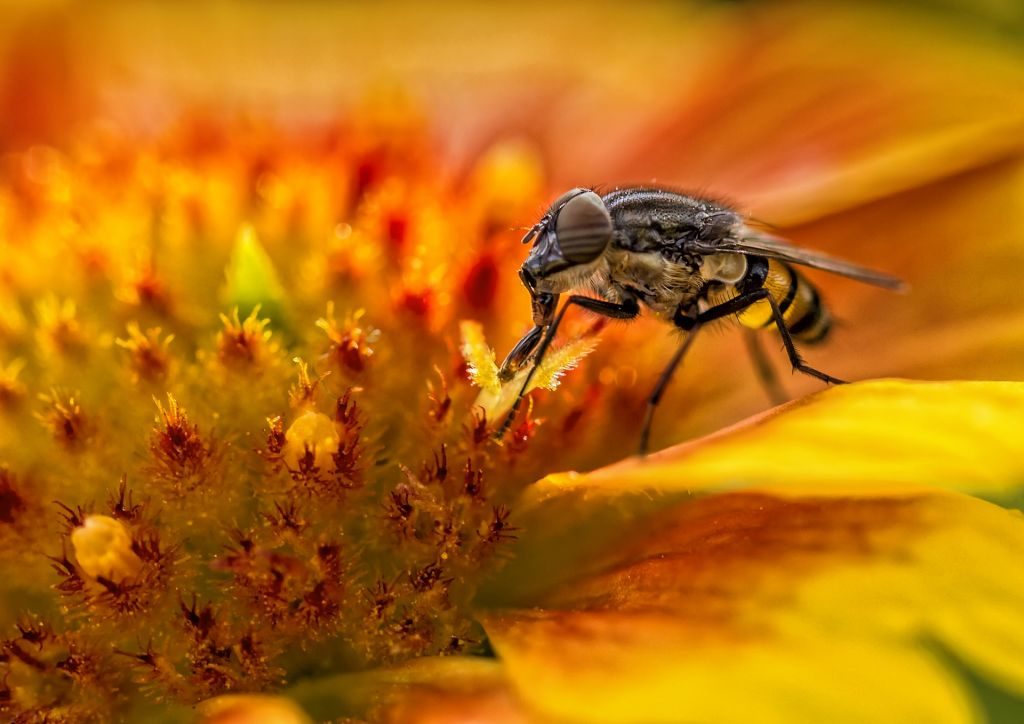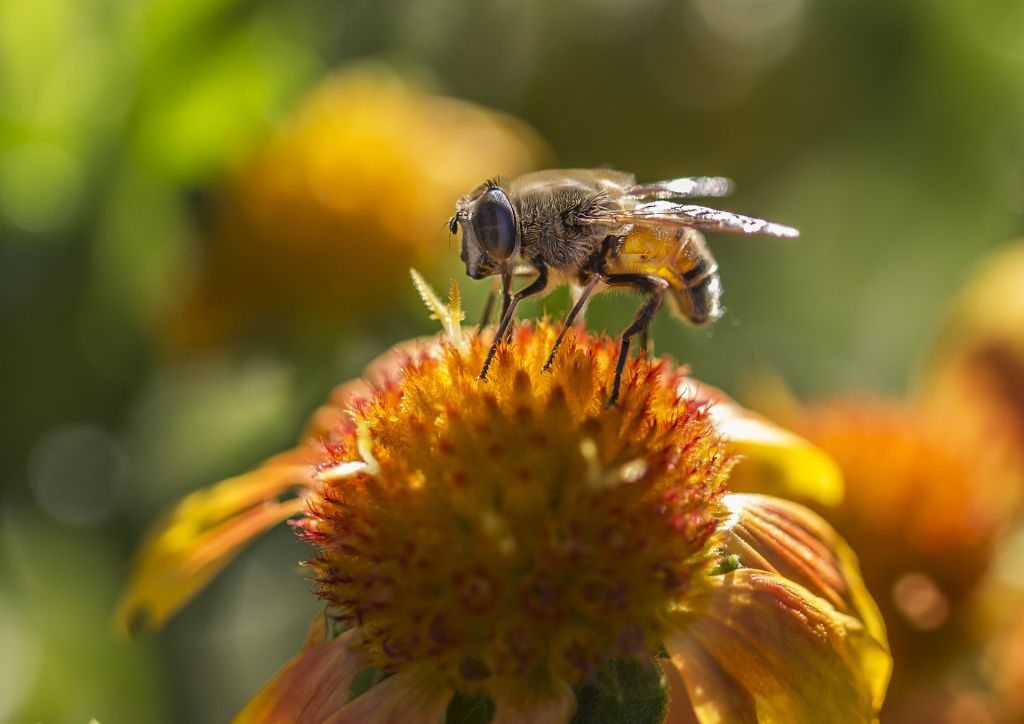If you purchase an independently reviewed item through our site, we earn an affiliate commission. Read our affiliate disclosure.
For a better part of the last century, bees were primarily kept for purposes of producing honey. Pollination at the time occurred as a side benefit. Nonetheless, as the number of fields that require pollination increased and natural pollination declined, the practice of beekeeping for pollination – renting honeybee colonies for pollinating crops, became popular. At the present day, literally thousands of bee colonies are rented by growers of a wide variety of crops that need pollination. This practice is not only common in the United States but throughout the entire world.
Bees that are reared solely for commercial pollination are managed differently. The key focus is not the honey or wax produced but rather the fruit or seed produced. The honey and wax are treated as an additional benefit to the beekeeper. Growers who need bees for pollination, may desire to keep their own bees but it is difficult for most of them to do this. Renting is a feasible option to most of them since it is never easy to maintain large numbers of robust hives throughout the year. Professional beekeepers are the only ones who can handle such a task and ensure the bees stay in excellent condition year-round.
Requirements for Beekeeping for Pollination
1. Beehives
The beehives are of course required for this practice and not just any kind of hive. Uniform hives that are in excellent condition are required so that it becomes easy to load and unload the hives. All features of the hives should be standard such that they can be stacked together without any problems.
2. Vehicles
Beekeeping for pollination entails lots of movement from one crop field to the other and therefore a reliable mode of transportation is required. Trucks and trailers are the ideal mode of transportation for this venture. They should have smooth flatbeds and hooks on the edges where ropes can be tied to keep the hives securely in place.
A mechanical loader and forklifts make it easy for the beekeeper to load and lift the hives from the ground to the trucks or trailers.
3. Written Agreement or Contract
The beekeeper and the grower usually sign a contract that lays down precisely what each one of them is required to do with regard to the pollination service. This contract of agreement is usually read and signed prior to bee movement to the field for pollination.
Some of the information laid down by an agreement includes:
- Names or identification of the parties involved.
- Number of hives or colonies.
- Rental price.
- Strength of the bee colonies.
- Delivery date.
- Location or where the colonies will be placed.
- Length of pollination period.
- Water supply for the bees.
- Hive safety from pesticides.
- Access to the beekeeper.
- End date or date of removal of hives from the crops.
- Payment methods, rewards, or penalties.
Preparing a Bee Colony for Pollination
A lot of work is required before a bee colony is selected and delivered for pollination. The beekeeper has to choose the right colony and undertake all the preliminary preparations and deliver the colony for pollination.
1. Choosing the Stock
This is an important step in beekeeping for pollination. Colonies bred for pollination are those headed by young queens of gentle stock. This will reduce colony failure and reduce the possibility of people getting stung.
The colony population should also be controlled through proper timing of the colony development. Bee colonies with a large population send a greater proportion of the bees to collect pollen and nectar. A small one on the other hand will send a fewer number since a high percentage of the bees must always remain to safeguard the brood. A good pollination colony is one with the capability of sending a large number of foraging bees. Remember pollination occurs only through foraging.
2. Food Reserves
Bee colonies used for pollination should have ample honey supplies since they are moved from one location to the other. A minimum of 2 frames of honey per colony is sufficient. The beekeeper should not rely on the nectar and pollen on the pollinated fields. In most cases, the nectar is scarce and more feed is needed for the colony sustenance. The beekeeper should therefore ensure sufficient amount of honey is available before moving the colony to any new area.
3. Choosing a New Location
While considering a new location, the beekeeper and the farmer should conduct day time visits to the area. This helps decide on what areas to place the colonies. Night visits can be challenging since it is never easy to ascertain the locations for hive placements at night.
It is also important to consider the field where the colonies will be placed. Small fields should accommodate a group of colonies within close proximity. Larger fields need to be well planned for since the location and distribution of the colonies should make it possible for the bees to access all the crops in the field. It is also important to consider competing plants. The wind direction and the direction bee entrance do not affect the how or where bees forage since they always distribute themselves almost uniformly in all directions.
Accessibility and convenience should also be considered when evaluating an area to be pollinated. The beekeeper should get an easy access to the area so as to facilitate colony examination, colony expansion, and honey removal. Feeder roads and roadways should also allow for the beekeeper’s vehicles to turn.
Welfare of the Bee Colonies
One of the most important considerations for the bees is shade and water source. If a natural water source is available within close proximity, then that can be perfect. Otherwise, a temporary water source should be availed by either the farmer or the beekeeper. This will eliminate the need for large numbers of bees to seek water in nearby tanks or near homes. This can create problems within an area. The bee colonies should also be protected from full sunlight by locating the hives under tree shades, building temporary shades or placing hives near vegetation.
The bees should also be protected from harmful chemicals such as pesticides. Crops to be pollinated as well as those within the neighborhood should be free from pesticides. Another key consideration is losses resulting from theft. The area should be accessed through an occupied house or should only be accessible through a farmyard. Other important considerations include possibility of floods, wind damage, or fire breakouts.
Moving Hives
Most beekeepers prefer to move their beehives at night since at this time, bees are not flying about and it is cooler. The hives are usually screened on the entrances then loaded into a pick-up truck. Those beekeepers with large beehives to handle, should organize the hives in groups of four or more then load them into a trailer or truck using a forklift. The farmer should therefore be prepared for a night time arrival. This explains why it is important for the beekeeper and the farmer to meet in the field on day time. It is the only time to facilitate planning for access to the field and placement of the hives.
Proper timing should also be considered when moving the bees to the field. The right time to bring in a bee colony for pollination is at the onset of crop flowering. This will help direct the bees to the right crop. Any mistake may lead to the pollination of competing weeds.
Wildflower Planting
Wildflowers and other natives are friendly to bees and butterflies. They are well-suited for different climatic conditions, more so, country regions where there is plenty of indigenous wildlife. If you have a bee garden then you should consider introducing wildflowers and other natives. Those unlimited with space can convert their lawn or patch into a wildflower zone.
Wildflower seeds are available in a range of mixes tailored for varying climatic conditions. You also get some varieties tailored for butterflies and bees. Some of the best wildflower plants to consider include the following:
- Summer and Spring Wildflowers – Red Campion, Selfheal, Bugle, Comfrey, Poppy, Betony, Foxglove, Dandelion, Woundwort, Yellow Rattle, Vetches, Cat’s Ear, Dead-nettle, and Ground Ivy.
- Summer and Autumn wildflowers – Comfrey, Bramble, Bird’s Foot Trefoil, Clovers, Burdock, Cat’s ear, Teasels, Angelica, Vetches, Knapweed, Thistles, Sainfoin, and Red Bartsia.
- Autumn and Winter wildflowers – Ivy and Devils’ bit scabious.
When considering buying wildflowers for your garden, choose a mixture that is blended for bees and butterflies. You should also consider a variety that is in line with your soil type and conditions. This will increase your chances of success. You should also check out with your local environment agency to ascertain whether your chosen plant species is acceptable within your country or locality. Make use of the various online resources when checking out for this.
Pollinating Fruit Trees
Fruit trees fall into three categories: cross-pollinated, self-pollinating, and semi-fruitful. The cross-pollinated trees are the majority and rely on cross-pollination to thrive. These include plants such as sweet cherries, pears, and many others. Examples of self-pollinating ones include figs, peaches, and sour cherries. The semi semi-fruitful variety of plants includes apples and is ideally plants that do not necessarily rely on cross-pollination to thrive. Nonetheless, they yield more when subjected to cross-pollination.
Cross-pollination can only be successful when two or more varieties of the plant are planted side by side or when grafted onto one of the trunks. You should also ensure that the two plant varieties bloom at the same time for cross-pollination to be successful.
Tips for fruit tree pollination:
- When planting apples and pears, ensure you have a second tree nearby for cross-pollination to occur. These trees flower best during cool and rainy weather. You should also pollinate crops of the same genus, example pears with pears and apples with apples.
- Plums and cherries rely on cross-pollination but you have to ensure planted close together bloom at the same time.
- Grapes are self-pollinating and do not rely on cross-pollination to thrive. Two or more varieties planted close to each other helps propagate hybrids since they have non-viable pollen.
- Blueberries are ideally self-propagating but give better yields when two or more varieties are plant close to one another.
- Kiwi fruit plants are also self-pollinating with one male plant propagating up to 8 female plants.
- Strawberries and Raspberries self-pollinate also.
The honeybee will help pollinate fruit trees such as the above mentioned varieties.
Bulb planting
Flower bulbs are easy to grow and are bee friendly. They are quite versatile and can be grown in a wide variety of soils and fields. Some of the bulbs varieties that do well in lawns include snowdrops, crocus, and the short stem fritillaria. These can be planted in lawns, in-between flower clumps, and borders.
Some bee friendly bulbs such as blue bell, wood anemone, cyclamen, and snowdrop are best-suited for areas we may consider as hardy. They can be planted in shady spots within the garden and other problematic areas. Tall Alliums and Agapanthus are ideal for summer flowering, and flower for long. Bumblebees in particular are attracted to Allium and honeybees love Agapanthus.
Flower bulbs are easy to grow and suits most gardens since it blends well with other flowers and plants. They also have an aesthetic value attached to them. Some bee friendly bulbs include the following:
- Best for winter – Winter Aconite, Chionodoxa spp, Snowdrop.
- Ideal for Spring – Iris, Crocus, Hyacinth, Cyclamen, Daffodil, Bluebells, Muscari, and Anemone Nemorosa.
- Best for Summer – Allium, Agapanthus, Ornithogalum, Crocosmia, and Foxtail Lily.
Conclusion
Beekeeping for pollination is a popular practice all over the globe. Most beekeepers who rent out their bee colonies for pollination services have realized the huge benefits bees can reap them in addition to the usual wax and honey. A single hive has the potential of earning hundreds of dollars in pollination services not to mention the amount hundreds of hives can earn as well within the same season. It is also worth noting that the honeybee also helps propagate some fruit trees, flower bulbs, and wildflower planting.
References
- https://bees.caes.uga.edu/bees-beekeeping-pollination/pollination/pollination-managing-bees-for-pollination.html
- https://bees.caes.uga.edu/bees-beekeeping-pollination/pollination/pollination-background.html
- https://agricultureandfoodsecurity.biomedcentral.com/articles/10.1186/s40066-016-0053-9
- https://www.fda.gov/animal-veterinary/animal-health-literacy/helping-agricultures-helpful-honey-bees
- https://www.scientificamerican.com/article/migratory-beekeeping-mind-boggling-math/
- https://www.usda.gov/media/blog/2017/06/20/being-serious-about-saving-bees
- https://www.unep.org/news-and-stories/story/why-bees-are-essential-people-and-planet
What are your thoughts on this article? Leave a comment below and let us know.
 BeeKeepClub Resources and Guides for Beekeepers
BeeKeepClub Resources and Guides for Beekeepers






[…] growers that produce about 80% of the world’s almonds, enlist commercial beekeepers to provide pollination services during the flowering seasons. This is done in an effort to keep the almond trees more productive. […]
[…] growers that produce about 80% of the world’s almonds, enlist commercial beekeepers to provide pollination services during the flowering seasons. This is done in an effort to keep the almond trees more productive. […]
[…] a practice that helps large-scale agricultural farms to optimize their productivity by contracting pollination services from beekeepers. More than 1 million beehives are transported annually to farms within the US to […]
[…] a practice that helps large-scale agricultural farms to optimize their productivity by contracting pollination services from beekeepers. More than 1 million beehives are transported annually to farms within the US to […]
[…] play the role of converting nectar into honey using their enzymes. Moreover, honeybees also provide pollination services, and this is where bee brokers come in. A bee broker may be described as the individual who is in […]
[…] clay, chewed plant tissue or grit in making a nest. Mason bees are increasingly reared for their pollination abilities in the production of fruits and […]
[…] mason bees is important to many people because of its function in plant pollination. This ultimate guide to keeping mason bees takes you through various practices for best result. […]
[…] bees are better at plant pollination than honeybees. Here is an exploration of solitary beekeeping and tips for success with mason and […]
[…] more than 14 billion dollars annually. Many crops that are important to human life in the country depend on honey bees for pollination. Production of plants is increased by pollination only. Other practices in agriculture such as the […]
[…] when it they are applied in foraging areas that the bees visit. Plants benefit a lot from the pollination activities that honeybees and other pollinators carry out. It is sad that the pollinators die in the process […]
[…] will pollinate most vegetables and fruits and can serve well in most commercial farms that require pollination services. Some of the crops and fruits pollinated by leafcutter bees include alfalfa, blueberries, carrots, […]
[…] to pollinate most greens and fruits and might serve nicely in most business farms that require pollination providers. A few of the crops and fruits pollinated by leafcutter bees embody alfalfa, blueberries, carrots, […]
[…] to keeping nature balanced. Hobbyist beekeepers get a lot of satisfaction from knowing they promote better pollination of plants. Honeybees in a single colony can cover very large areas with their pollination activity as they […]
[…] lovers are bound to enjoy the benefits of having a variety of flying bugs and bees in their garden. Pollination when you have one or two of these houses is easy in your garden. The bug house is a well thought […]
[…] Honeybees are raised for not only the honey they make but also for other important services such as pollination services. Beekeeping has fascinated many since there is so much to learn about it. In this article, […]
[…] bright yellow flowers of the cucumber attract the honey bee. The flowers are not so good for pollination given the fact that they tend to be concealed by the broad leaves. You might have to include […]
[…] bees, orchid bees have fewer hairs on their abdomen. They exhibit unique behavior, specializing in pollination, making them highly efficient pollinators. Male orchid bees have hairs on their front legs for […]
[…] bees have fewer hairs on their stomach. They show off distinctive conduct, that specialize in pollination, making them extremely environment friendly pollinators. Male orchid bees have hairs on their […]
[…] mason bee kits available come with mason bees and other solitary bees that beekeepers raise for pollination purposes. Mason bee kits with bees are great for both home gardens and large agricultural purposes. Mason […]
[…] large numbers of honeybee colonies over long distances is necessary in pollination season. Beekeepers providing pollination services to farmers have come up with ways to ensure […]